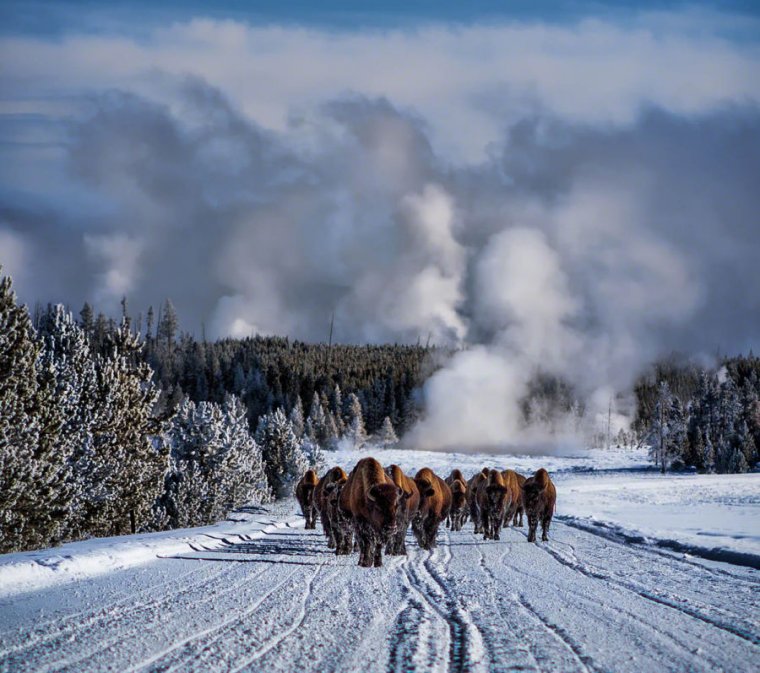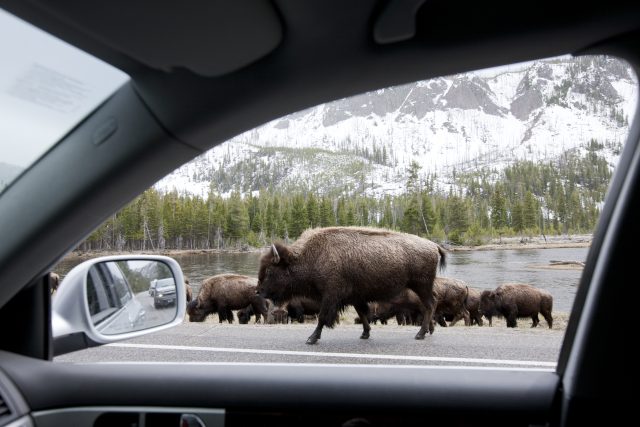buffalo buffalo —
Bring wild bison to the Great Plains, restore one of the world’s most endangered ecosystems.
Louise Johns, Undark
–

On a blustery October afternoon at the Wolfcrow Bison Ranch in southern Alberta, Canada, Dan Fox and his ranch hand, Man Blackplume, tried to wrestle fence panels into place despite a 60 mph wind. The next day was weaning day—and the fence needed to be rock solid so the bison calves could be separated from their mothers.
The two members of the Kainai First Nation, also known as the Blood Tribe, braced their bodies against the 12-foot-high fence panels so they could nail them to the posts, but the panels flapped in the wind like giant wooden flags. Across the pasture, 30 bison stood huddled together in the corner, unfazed by the commotion. They were part of the first bison herd to grace the Blood Reserve in 150 years, Fox says. The Kainai First Nation is one of four tribal groups within the Blackfoot Confederacy, which includes the Blackfeet Tribe in Montana.
Fox, 63, believes the animals may have helped extend his life. He experienced a cancer scare more than 20 years ago, and at the suggestion of a Blackfoot healer and naturopath, he changed his diet, replacing processed food with bison meat and other ancestral foods. His health improved, and today he says he feels better than ever. He is convinced that his family and his community will benefit, as he did, by having the buffalo back on the land and in their lives. (Bison bison is the scientific name for the animal, but buffalo is the word that most Indigenous people use.)
More importantly, he said, the bison began to teach him about his culture and what it means to be a Blackfoot. “The elders from back in the day predicted that the only way the Native people are going to start gaining ground again, their ways of life, is when the bison come back,” said Fox.
Research suggests there were 30 million to 60 million bison in North America in the 1500s. Four hundred years later, roughly 1,000 bison remained, a result of government policies that encouraged killing off the animals, largely to help defeat Indigenous inhabitants and force them onto reservations.
Fox and Blackplume’s ancestors not only relied on bison for sustenance, but depended on the Great Plains ecosystem that the bison coevolved with. Today, that ecosystem is among the most endangered in the world: according to recent estimates, about half of the North American Great Plains region has been converted to cropland, development, or other uses—with more conversion happening every year. When the land is converted for these uses, biodiversity declines and habitats are fragmented, making the land less resilient to global forces such as a changing climate.
In the early 2000s, Fox turned a cattle ranch into a bison ranch, part of a movement across the North American West to return bison to parts of their historic range for the collective well-being of various Indigenous nations in Canada and the United States. Several tribes have started their own herds, often on ground that had previously been used for cattle grazing. But the overarching vision for many Indigenous tribes is restoring free-ranging wild herds on tribal and public lands, and in the process, protecting and enhancing the remaining grasslands where the bison once roamed. But there are social and political challenges that have long stood in the way of bringing this vision to life.

Enlarge / Yellowstone National Park, view through window driving past herd of Bison walking along the road in the snow.
Getty Images
Restored
There are now roughly 500,000 bison in North America, occupying less than 1 percent of their historical range. All but a few herds, such as the Yellowstone herd, Utah’s Henry Mountains herd, and the Banff National Park herd, live within the confines of fences. Even the so-called wild herds are not welcome outside parks and protected areas. This is largely because many livestock ranchers don’t want the competition for space and grass and are worried about the spread of brucellosis, a disease that can cause livestock, as well as deer, elk, and other wildlife, to miscarry their fetuses.
Outside of Yellowstone National Park, Native American tribes with treaty rights, including the Blackfeet Tribe in Montana and several other Northern Plains tribes, are allowed to hunt the animals as they leave the park, one way of managing the park’s bison population. Until recently, all the remaining bison were sent to slaughter. But Native American tribes and the Intertribal Buffalo Council (a federally chartered organization that represents tribal nations that want to restore bison to their reservations) are trying to change that. Instead of excess bison being sent to slaughter, they would like to see those animals restored to Native American reservations that want to start their own herds and supplement existing herds. A facility built by the Assiniboine and Sioux Tribes on the Fort Peck Reservation specifically for quarantining Yellowstone bison has been attempting to do just that. With the Fort Peck program, Yellowstone bison are trucked from the holding facility outside the park directly to the Fort Peck Reservation, where they are quarantined until they go through rigorous testing for brucellosis (which can take up to two years).
Many of the region’s Native American and non-native ranchers currently raise cattle, but over the past decade, research has pointed to bison as a more ecologically beneficial choice.
“There are small, nuanced differences that have great implications,” said Keith Aune, a conservation biologist and former bison specialist for the Wildlife Conservation Society, a non-governmental organization headquartered at the Bronx Zoo that works to protect wildlife and wild places. One of the biggest differences is that cattle tend to stick close to water sources and roam less widely than bison. Most breeds of cattle came from Europe, where they thrived in wetter and more confined spaces. “It depends on what you want to create,” said Aune. “If you want to create a monoculture with maximum pounds of grass,” then grazing “cattle would produce that outcome.
“But if you’re looking for complex ecosystems with resilience and the ability to survive climate change and adapt to significant dynamics schemes that are playing out in our world,” he continues, “you would not graze cattle, and certainly not only cattle.”
Another advantage bison have over cattle is their ability to adjust their metabolism to suit environmental conditions. In winter, their range is the same as in summer, but they consume fewer calories, and they can survive on much less forage during a drought year, for example.
“Having bison back on the land is such a beautiful idea,” said Colleen Gustafson, a rancher in northwest Montana and member of the Blackfeet Nation Stock Growers Association. But, she added, “the people whose backyards it affects… are far different than those who live in town, or those whose livelihood does not depend on a rangeland and fences.”
Even so, bison are a potent symbol for tribes across the Northern Great Plains, and some of their members are tired of others telling them what is appropriate or allowed on their ancestral lands. “[Bison are] an animal that used to be so free,” said Helen Augare Carlson, a member of Montana’s Blackfeet Tribe. “Cows, they’re used to being fed. They’re going to wait to be fed. And that’s how we [Native Americans] got to be. We were penned for so long,” she said. After government policies drove bison to near-extinction, Augare Carlson said her people were forced to depend on the government for food. “We didn’t go out and hunt anymore. We waited for those rations, and that’s what killed us.”
Augare Carlson is referring specifically to the Starvation Winter of 1883 to 1884, when the buffalo had been almost entirely killed off, and the US government did not have adequate rations or supplies to feed the Blackfeet people through frigid winter storms on the northern plains of Montana. As a result, nearly 600 Blackfeet men, women, and children—more than a sixth of the tribe’s population—died of malnutrition.

